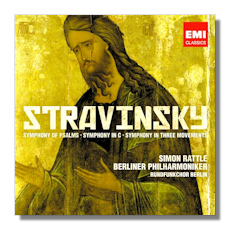
The Internet's Premier Classical Music Source
Related Links
- Stravinsky Reviews
- Latest Reviews
- More Reviews
-
By Composer
-
Collections
DVD & Blu-ray
Books
Concert Reviews
Articles/Interviews
Software
Audio
Search Amazon
Recommended Links
Site News
 CD Review
CD Review
Igor Stravinsky

Symphonies
- Symphony in Three Movements
- Symphony of Psalms
- Symphony in C
Berlin Radio Choir
Berlin Philharmonic Orchestra/Simon Rattle
EMI Classics 2-07630-0 2008 75:37
These works from the 1930's and 1940's can be said to represent the quintessence of "neoclassicism" and are among the most striking works of the last century. Stravinsky wrote the Symphony of Psalms for chorus and orchestra minus violins, violas and clarinets for the 50th anniversary of the Boston Symphony Orchestra, and revised it in 1948 (the version recorded here.) The Symphony in C was written with the New York Philharmonic originally in mind but premièred by the Chicago Symphony in 1940. The Symphony in Three Movements did get its première from the New York philharmonic in January 1946.
I have a strong tendency to look to Stravinsky's own performances, which tend to emphasize a staccato angularity of phrasing, as the norm for these works, though he was on record as praising the performances of Ansermet, which tended to round the corners, so to speak. Looking back from the vantage point of his eighties (in 1963) Stravinsky criticized his own "succession of ostinatos" in the Symphony in C. Could he have heard Rattle's performances of these symphonies, Stravinsky would not have been displeased, I think. Rattle's phrasing is always clearly articulated, razor sharp in fact, and he manages to cope with Stravinsky's sudden and varied shifts in mood, dynamics and tempo, from light, upbeat and playful, to slashing and intense, with sometimes heavy, even ponderous moments.
The Symphony in C's opening movement is given simply a metronome marking by Stravinsky, but even that movement is considerably varied. The following "Larghetto concertante" is relaxed, flexible and songlike for half its duration than suddenly intense. The Allegretto shows some vigorous contrasts and reveals a concerto grosso offsetting of larger and smaller forces. These symphonies, in fact, often come close – at least – to being chamber symphonies, more than I had noticed previously.
The Symphony in Three Movements contains some strong echoes of Sacre du printemps, with similar slashing phrases in the opening and closing movements. The middle movement is quiet and gentle in contrast, with lighter orchestration: a harp and flute are heard together at one point and other passages sound much like a woodwind quartet. There is a brief moment two thirds of the way through the movement that I swear sounds Coplandesque! The finale's vigor is emphasized with brass and drums but is relieved with a brief piano solo and a characteristically neoclassical lightness before renewed intensity.
The Symphony of Psalms, for chorus and reduced orchestra, has three movements, with the successive movements each twice the length of the previous one. The texts are in Latin. The opening "Exaudi" is declamatory and builds simply, steadily and strongly. The second movement begins slowly and solemnly, for solo oboe and then flutes, in counterpoint for a good two minutes before the chorus enters, with multiple lines of melody. There is a lot of counterpoint. A sustained loud outburst is maintained for most of the rest of the six and a half minutes. The final movement, "Laudate," is one of Stravinsky's most beautiful pieces. The dominant mood is quiet and lovely but there are fast, furious and loud passages with the strong, sharp irregular rhythms that Stravinsky loved to write and which Rattle handles with ease. Both at the beginning and for a long stretch toward the end a soft regular drumbeat underlies a legato vocal line. In one passage this slow steady rhythm underlies the male voices uttering a syllable at a time between rests for the voices. The slow, quiet legato line continues for a long time to the end of the piece.
The sound is good. The woodwinds come across especially clearly. Recommended.
Copyright © 2009, R. James Tobin




















